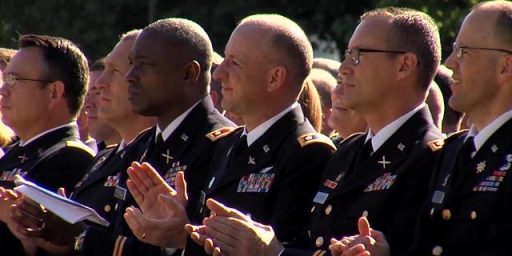Stryker Off to Good Start
Mike Burleson at StrategyPage:
The Army̢۪s new Interim Combat Vehicle is proving itself in Iraq. Encased in a cage of slat armor, a Stryker recently shrugged off a direct hit by a rocket-propelled grenade (RPG), with minor damage and no casualties. The incident reportedly happened in the Mosul district of Northern Iraq.
Slats were added to the Stryker after being deployed to the war zone in November 2003. The cage of armor that circles the vehicle is similar to anti-torpedo nets that used to protect battleships in port. When an RPG hits, it is defused between the main armor and the outer covering. The armor performed as expected with only one vehicle lost in combat since its debut with the 3rd Brigade, 2nd Infantry Division. This 19-ton Stryker became a total loss when hit by an improvised explosive device. All 4 crewmembers escaped with only minor injuries.
The recent unsuccessful attack seems to justify the faith military leaders are placing in the Army̢۪s new combat vehicle. Critics in and out of the service have been highly vocal about supposed flaws in the design and concept of Stryker. They claim the vehicle to be too heavy, vulnerable to small arms fire, and a poor substitute for the main battle tank. Supporters say it is not a tank replacement but a highly mobile battle taxi, and with a new 105-millimeter cannon, an infantry support weapon.
Weight has been a problem with the Stryker. Off road the vehicle can bog down, and its built in winch is unable to rescue the vehicle in soft sand. To load the vehicle on a C-130 transport aircraft, a prime requirement in the design, much extra equipment and armor must be disassembled. After reaching a landing zone, the Army claims Stryker can be reassembled in 17 minutes.
The Interim Combat Vehicle, based on a Marine light armored vehicle, was ordered in November 2000 as part of an Army plan to deploy a combat brigade to a crisis zone within 96 hours. Six Stryker Brigades are being raised, each consisting of 366 vehicles. Stryker travels on 8 wheels at speeds of 60 miles per hour, and off road by deflating its tires. Range is 300 miles. Variants include a mobile gun system, an infantry carrier, mortar carrier, anti-tank vehicle, and NBC reconnaissance vehicle.
As the new brigades are forming, doubts persist about the design. Critics are supporting conventional track vehicles, such as the Vietnam era M-113 armored personnel carrier, which they claim can be easily upgraded to LAV standard at less cost than Stryker. The design is not without merit, as large numbers of the workhorses remain in service, and are better off-road vehicles. It is doubtful however, that a new generation of warriors will accept such a dated design unless forced to do so.
Tank advocates point to the LAVs vulnerability in a combat situation, though the recent attack in Mosul may blunt this argument somewhat. The Stryker̢۪s original specification called for it to withstand hits from 50 caliber bullets and airburst shells. Tankers point to the great success of the M-1 Abrams in the recent invasion of Iraq, and the swift capture of Baghdad, without major loss.
It is also a fact that because of excessive cost, weight, and a growing vulnerability to new technologies, the tank̢۪s day may be fading. Most of the world̢۪s armies are equipping themselves with cheaper and more mobile LAVs, most recently Canada and Israel. For the first time in decades there are no new designs for main battle tanks underway in any army, other than updating older vehicles. Though armor is still a deciding factor in modern war, the conflict in Iraq, and a tank no one wanted, is proving light vehicles can be protected at less cost and near equal performance.



I always chuckle at the Army guys and their arguments.
The tanks fans think every vehicle should be a tank. The speed guys say every vehicle should be fast. The off-road guy say every vehicle should be able to go thru a swamp.
I never heard an Airforce guy complain that a C-130 could not dogfight or an F-15 could not carry a tank in its belly.
We have different tools for reasons.
The problem is that the Army has to be deployed to fight; the Air Force is pretty much self-mobile. Further, we can’t simply have multiple armies to fight any of the myriad missions that may arise; units have to be able to do virtually anything.
Heavy tanks and artillery are wonderful tools but they’re not very practical given that most of the fighting is going to be done in places that can’t be gotten to with those platforms.
I realized after I wrote it that it sounded like I was knocking them… It was not meant that way.
I just love tankers that think that every vehicle in the Army need 18 inches of DU armor. It’s kinda funny the way people look at things, that’s all.
Before the infantry are committed I’d like to see the two B’s, George and Tony, ride through Ambush Alley in a wheeled steel box just 1/2″ thick with RPG’s flying about. Then perhaps I’d feel it’s a an acceptable vehicle…..
—